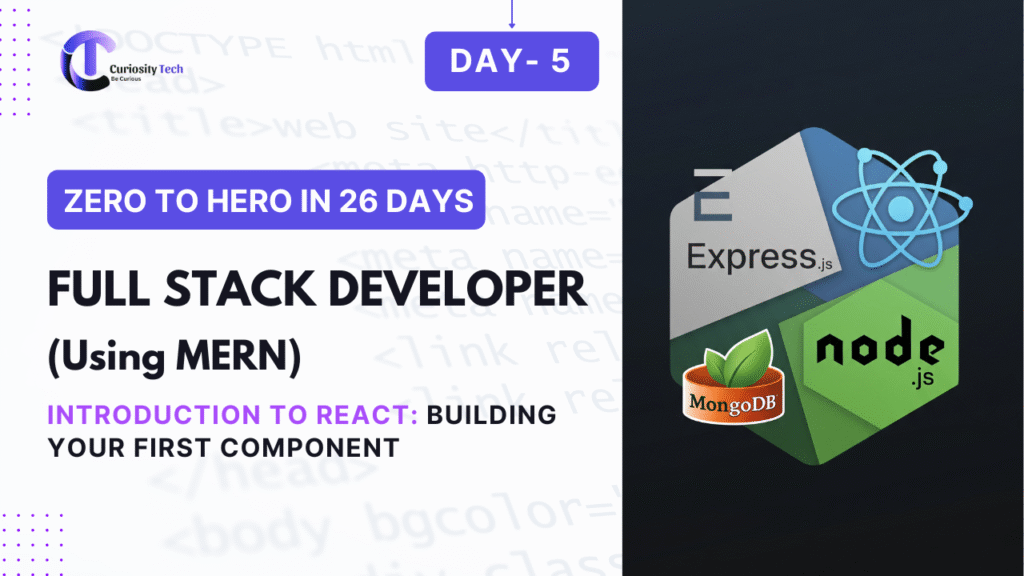Introduction
React has become the backbone of modern frontend development. As the “V” in the MERN stack, React empowers developers to create dynamic, responsive, and highly interactive user interfaces. Understanding how to build components in React is the first step toward becoming a proficient MERN Stack developer.
React components are the building blocks of any React application. They encapsulate UI logic, presentation, and behavior, allowing developers to build modular, reusable, and maintainable code. For aspiring MERN Stack developers, mastering components is essential not only for frontend functionality but also for seamless integration with Node.js, Express, and MongoDB.
CuriosityTech.in has long advocated hands-on learning, and exploring React through components is one of the best starting points for those serious about building robust web applications.
What is a React Component?
A React component is essentially a JavaScript function or class that returns a piece of UI. Components can be either:
- Functional Components – These are simple JavaScript functions returning JSX (JavaScript XML). They are ideal for components that do not require internal state or lifecycle methods.
- Class Components – These are ES6 classes that extend React.Component. They are more suitable for components that require state or lifecycle hooks, though functional components with hooks have largely replaced class components in modern React development.
Example Conceptual Diagram:
This diagram shows the hierarchical structure of a React application where components are modular and reusable.
Building Your First Functional Component
Functional components allow developers to build simple yet powerful pieces of UI. Consider this workflow:
Create a component folder structure:
src/
components/
Header.js
Define the component:
function Header() {
return <h1>Welcome to My MERN App!</h1>;
}
export default Header;
Render in the main App.js file:
import Header from ‘./components/Header’;
function App() {
return (
<div>
<Header />
</div>
);
}
export default App;
Even though this seems simple, understanding component composition and hierarchy is key to scaling any React application.
Best Practices for React Components
To write professional React code that aligns with industry standards:
- Component Reusability: Keep components small and purpose-driven.
- Separation of Concerns: Avoid mixing UI logic with backend API logic.
- Use of Props: Pass data dynamically to components using props instead of hardcoding values.
- Hooks and State Management: Even in simple components, understand the use of useState and useEffect hooks for state and lifecycle management.
Table – Components Overview:
| Component Type | When to Use | Key Features |
| Functional Component | Simple UI with minimal logic | Lightweight, easy to test |
| Class Component | Complex UI with state and lifecycle methods | Access to this.state and methods |
| Pure Component | Performance optimization for static props | Prevents unnecessary re-renders |
How to Become a React Expert
- Hands-On Practice: Build small apps daily (e.g., to-do list, calculator, blog layout).
- Understand JSX: JSX is not HTML; it’s a syntax extension for JavaScript that requires careful handling.
- Component Composition: Learn how to nest components effectively.
- State Management: Master useState and useEffect hooks before moving to Redux.
- Integration Skills: Practice connecting React with backend APIs using Axios or Fetch.
At CuriosityTech.in, practical workshops help learners implement real-world projects in React and MERN Stack, transforming theoretical knowledge into hands-on expertise.
Infographic Idea
Title: “Anatomy of a React Component”
- Sections: Component Name → Props → State → JSX → Event Handlers → Export
- Description: Visual representation of how data flows in a React component and interacts with the rest of the application.
Conclusion
Mastering components is the foundation of becoming a proficient React developer. Once comfortable with building functional and class components, you’ll be ready to explore React hooks, state management, and integration with Node.js and MongoDB. Consistent practice, real-world project implementation, and following best practices will accelerate your journey to becoming a full-fledged MERN Stack expert.
CuriosityTech.in provides curated tutorials and mentorship to ensure learners gain both conceptual understanding and practical skills in React and MERN development.

